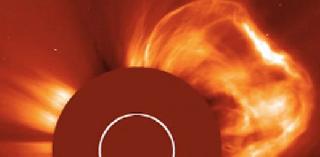
A NASA photo
WASHINGTON (BNS): Days after it unleashed a strong solar storm that hit the Earth, causing satellite interruption and producing brilliant northern lights, the Sun on Friday erupted again, this time triggering another massive flare.
According to NASA, the Sun unleashed an X1.8 class flare that began at 1:12 pm EST (1812 GMT) on Friday and peaked at 1:37 (1837 GMT).
The solar eruption from sun spot region 1402 was captured by NASA's Solar Dynamic Observatory.
The spacecraft had spotted another massive flare in the same region on January 22.
Friday's flare immediately caused a strong radio blackout at low-latitudes, which was rated an R3 on NOAA's scale from R1-5. The blackout soon subsided to a minor R1 storm.
The solar explosion resulted in coronal mass ejection (CME) and models from NASA's Goddard Space Weather Center predict that the CME is traveling at over 1500 miles per second, the space agency said.
It does not initially appear to be Earth-directed, but Earth may get a glancing blow, it added.
The X-class solar flares are rated to be the most powerful solar eruptions followed by M-class and C-class solar flares.
The most powerful solar flare measured with modern methods was in 2003, during the last solar maximum. The flare was so powerful that it overloaded the sensors measuring it.
As the number of solar flare increases every 11 years when the Sun moves to solar maximum phase, more such phenomenon may occur by 2013, according to NASA.
 Previous Article
Previous Article Next Article
Next Article













The Indian Air Force, in its flight trials evaluation report submitted before the Defence Ministry l..
view articleAn insight into the Medium Multi-Role Combat Aircraft competition...
view articleSky enthusiasts can now spot the International Space Station (ISS) commanded by Indian-American astr..
view article